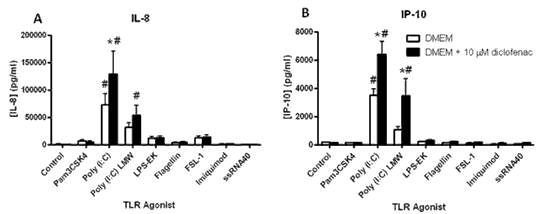Print version
Search Pub Med
Investigating the role of cyclooxygenase in toll-like receptor responses in lung fibroblasts Cyclooxygenase (COX) is the first enzyme in the conversion of arachidonic acid to the prostanoids. There are two isoforms of COX; COX-1 is constitutively expressed with a homeostatic role in most tissues, and COX-2 is induced by growth factors or at sites of inflammation. Lung fibroblasts are an important cell type in the pathogenesis of lung diseases such as idiopathic pulmonary fibrosis and are also essential for wound repair during inflammation resolution. Toll-Like Receptors (TLRs) are an important family of pattern recognition receptors (PRRs) that are expressed on lung fibroblasts and are essential in the innate immune response through the recognition of pathogen associated molecular patterns (PAMPs). The response of lung fibroblasts to TLR agonists has not yet been extensively researched, while research has shown that COX products such as prostaglandin E2 suppress TLR4-induced cytokine production1. Here, the role of COX in TLR responses in lung fibroblasts was investigated. Lung fibroblasts isolated from human patients were stimulated for 24 h with TLR agonists (fig 1). Some cells were pre-treated for 30mins with the dual COX inhibitor diclofenac (10 µM). The cytokines IL-8 and IP-10 were measured from cell supernatants using ELISA as markers of NF-κB- and Interferon-related responses, respectively. Lung fibroblasts from humans released more IL-8 and IP-10 in response to the TLR3 agonist poly (I:C) compared to other TLR agonists. Inhibition of COX in human lung fibroblasts resulted in significantly enhanced TLR3-induced IL-8 and IP-10 release. The data indicate that TLR3, a viral PRR, is the dominant TLR pathway in lung fibroblasts, and that cytokine release stimulated by TLR3 agonists is limited by COX activity.

Figure 1. IL-8 (A) and IP-10 (B) release from human lung fibroblasts stimulated for 24h (37oC, 5% CO2) with the TLR2/1 agonist Pam3CSK4 (1µg/ml), TLR3 agonists poly (I:C) and low molecular weight poly (I:C) (10 µg/ml), TLR4 agonist LPS (1 µg/ml), TLR5 agonist flagellin (10 µg/ml), TLR2/6 agonist FSL-1 (1 µg/ml), TLR7 agonist imiquimod (10 µg/ml) and TLR8 agonist ssRNA40 (10 µg/ml) following 30min pre-treatment with 10µM diclofenac (final DMSO concentration 0.1% in all treatments). Data are expressed as mean ± SEM for n = 9 from 3 experimental days using cells isolated from 2 patients. To test for significance between treatments and controls, a one-way ANOVA was used with Dunnett’s post-test (# = p<0.05). To test for significance between DMEM and diclofenac treatments, a two-way ANOVA was used with Bonferroni’s post-test (* = p<0.05).
1. Xu et al., 2008; J Imunol 2008; 180;2125-2131.
|
|

